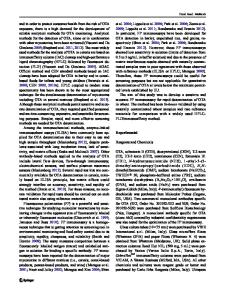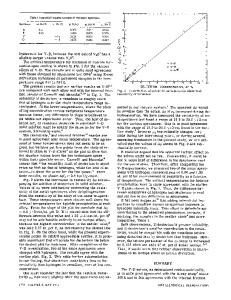Accurate Determination of γ′ Solvus in Ni-Al-X Ternary Systems
- PDF / 634,284 Bytes
- 12 Pages / 420.48 x 639 pts Page_size
- 33 Downloads / 867 Views
ACCURATE DETERMINATION OF y' SOLVUS IN Ni-Al-X TERNARY SYSTEMS YONG MYONG HONG*, YOSHINAO MISHIMA** AND TOMOO SUZUKI** *Graduate School, Dept. of Materials Science and Engineering, Tokyo Institute of Technology, Nagatsuta. Laboratory of Precision Machinery and Electronics, Tokyo Institute of Technology, Nagatsuta, Midori-ku, Yokohama 227, Japan
"**Research ABSTRACT
An attempt has been made to determine the y/y phase boundaries with particular emphasis on the y' solvus in ternary Ni-Al-X systems with X being one of the VA or VIA transition metal elements. It is shown that the y' solvus in each ternary system can be obtained as a surface with respect to composition and temperature by employing differential thermal analysis (DTA) as a key experimental technique with support from energy dispersive Xray spectroscopy combined with scanning elecron microscope(SEM-EDX). Also shown is that the DTA results often provide useful information on the phase relation in the vicinity of y and y ' phase fields. In the Ni-Al-V ternary system, for example, the pseudo-binary constitution between Ni 3 Al and Ni 3 V is suggested. The results presented here are systematic and consistent and therefore are reliable as compared with the previous results reported fragmentarily.
INTRODUCTION Phase diagrams of the Ni-Al-X ternary systems have been reported numelously through both experimental and theoretical works. However, when our interest is concentrated on the y/ y' equilibria, we have to admit that they are inconsistent and insufficient in quality. This is probably due to the fact that most of the works have tried to reveal the constitution over most of or the whole composition range in the system, making the evaluation of a particular phase relation dilute. The present work is designed to accurately and systematically evaluate the y/ y' equilibria in the Ni-AI-X systems. The ternary element X is chosen from the VIA(Cr, Mo and W) and VA(V, Nb and Ta) transition elements, and the y' solvus, here being defined as the solubility limit of y' in y solid solution, is determined by DTA. The results obtained here are superior to the experimental results reported previously because the solvus at any temperature, i.e. solvus surface, is obtainable. It then becomes possible to compare the present result with any previous result given only for a specific isothermal section, by which it is realized that in most cases there is a large discrepancy. However, the results of chemical analyses with SEM-EDX on the constituent phases for several alloys having two or three phases exhibit excellent agreements with the present DTA results in every system examined, which assures the accuracy of the present method. We have already pointed out that the compilation of the previous results is not sufficient to evaluate or estimate phase boundaries and tie lines, namely partitions of an alloying element, between two phases(l]. Accurate and systematic information on them would have the first priority to be provided in the fundamental approach for the effective alloy d
Data Loading...










